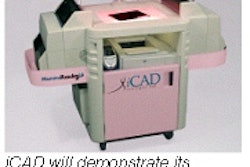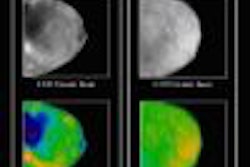CHICAGO - The visualization of calcified breast arteries on a mammogram appears to be linked to the woman’s risk of heart disease, researchers reported at the 88th annual meeting of the Radiological Society of North America.
Although the increased risk turns out to be elevated by a modest 20%, Dr. Kirk Doerger, a resident in radiology at the Mayo Clinic, Rochester, MN, said the finding was significant enough to warrant flagging the information on a patient’s chart.
Doerger and colleagues at Mayo created a breast arterial calcification score by counting how many of the three major arteries in each breast were visibly calcified on mammography. That number is divided in half, with a score of 1.5 or greater carrying the increased risk.
Doerger reviewed the records of more than 1800 women who had undergone mammography for breast cancer screening and had also undergone angiography to assess condition of coronary arteries within the same 12-month period.
“We think the correlation between these calcifications and heart disease is strong enough to warrant the radiologist noting these findings and suggesting to the woman’s primary care physician that further studies be implemented,” said Doerger.
He said that while the 20% increase does not necessarily imply urgent risk, the signs of calcification in the breast should prompt a primary care physician to take a detailed family history of the patient, as well as check her blood pressure and do tests for cholesterol levels and blood sugar levels. Discussions about changes in lifestyle, especially if the woman smokes, would also be in order, he said.
Putting the risk factor in perspective, Doerger said that the chance of heart disease is 110% higher in a woman who has diabetes or high blood pressure, 80% higher if she has high cholesterol, and 50% higher if she smokes cigarettes.
He said that 365,000 women die of heart disease each year, compared with 41,000 deaths from breast cancer. About 64% of the heart deaths occur in women who did not have symptoms prior to their fatal attack.
“The check of breast arterial calcification is free information,” said Doerger, adding that it doesn’t expose women to any more radiation, takes no more of their time, and doesn’t cost any more to do. Doerger said a radiologist should be able to determine the calcification levels of the arteries in a few minutes.
“The findings show that breast arterial calcifications occur in an age-related manner,” said Dr. Hedvig Hricak, chairman of the department of radiology at Memorial Sloan-Kettering Cancer Center in New York City. “But if these calcifications occur in a younger woman -- say in her 40s -- then it would be something that her primary care physician should know about because it could indicate early heart disease.”
Doerger said the Mayo Clinic is incorporating his findings into the radiology service routine -- creating a check-off system if the radiologist finds significant calcifications.
By Edward Susman
AuntMinnie.com
staff writer
December
4, 2002
Copyright © 2002 AuntMinnie.com



















